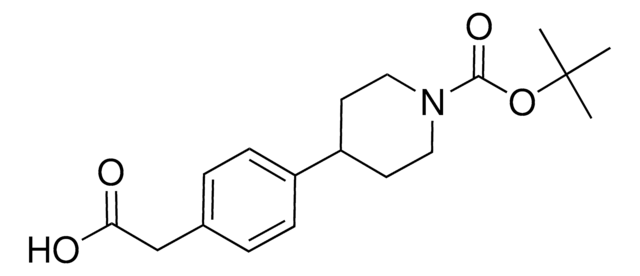916870
4-(1-(tert-butoxycarbonyl)piperidin-4-yl)benzoic acid
≥95%
Synonim(y):
Semi-flexible linker for PROTAC® development
About This Item
Polecane produkty
Poziom jakości
Próba
≥95%
Postać
powder
przydatność reakcji
reagent type: linker
grupa funkcyjna
Boc
carboxylic acid
temp. przechowywania
2-8°C
ciąg SMILES
O=C(N(CC1)CCC1C(C=C2)=CC=C2C(O)=O)OC(C)(C)C
InChI
1S/C17H23NO4/c1-17(2,3)22-16(21)18-10-8-13(9-11-18)12-4-6-14(7-5-12)15(19)20/h4-7,13H,8-11H2,1-3H3,(H,19,20)
Klucz InChI
YCNVQGGUCDVTIZ-UHFFFAOYSA-N
Zastosowanie
Inne uwagi
Informacje prawne
produkt powiązany
Hasło ostrzegawcze
Warning
Zwroty wskazujące rodzaj zagrożenia
Zwroty wskazujące środki ostrożności
Klasyfikacja zagrożeń
Aquatic Acute 1 - Aquatic Chronic 1 - Eye Irrit. 2 - Skin Irrit. 2 - Skin Sens. 1
Kod klasy składowania
11 - Combustible Solids
Klasa zagrożenia wodnego (WGK)
WGK 3
Temperatura zapłonu (°F)
Not applicable
Temperatura zapłonu (°C)
Not applicable
Wybierz jedną z najnowszych wersji:
Certyfikaty analizy (CoA)
Nie widzisz odpowiedniej wersji?
Jeśli potrzebujesz konkretnej wersji, możesz wyszukać konkretny certyfikat według numeru partii lub serii.
Masz już ten produkt?
Dokumenty związane z niedawno zakupionymi produktami zostały zamieszczone w Bibliotece dokumentów.
Nasz zespół naukowców ma doświadczenie we wszystkich obszarach badań, w tym w naukach przyrodniczych, materiałoznawstwie, syntezie chemicznej, chromatografii, analityce i wielu innych dziedzinach.
Skontaktuj się z zespołem ds. pomocy technicznej










